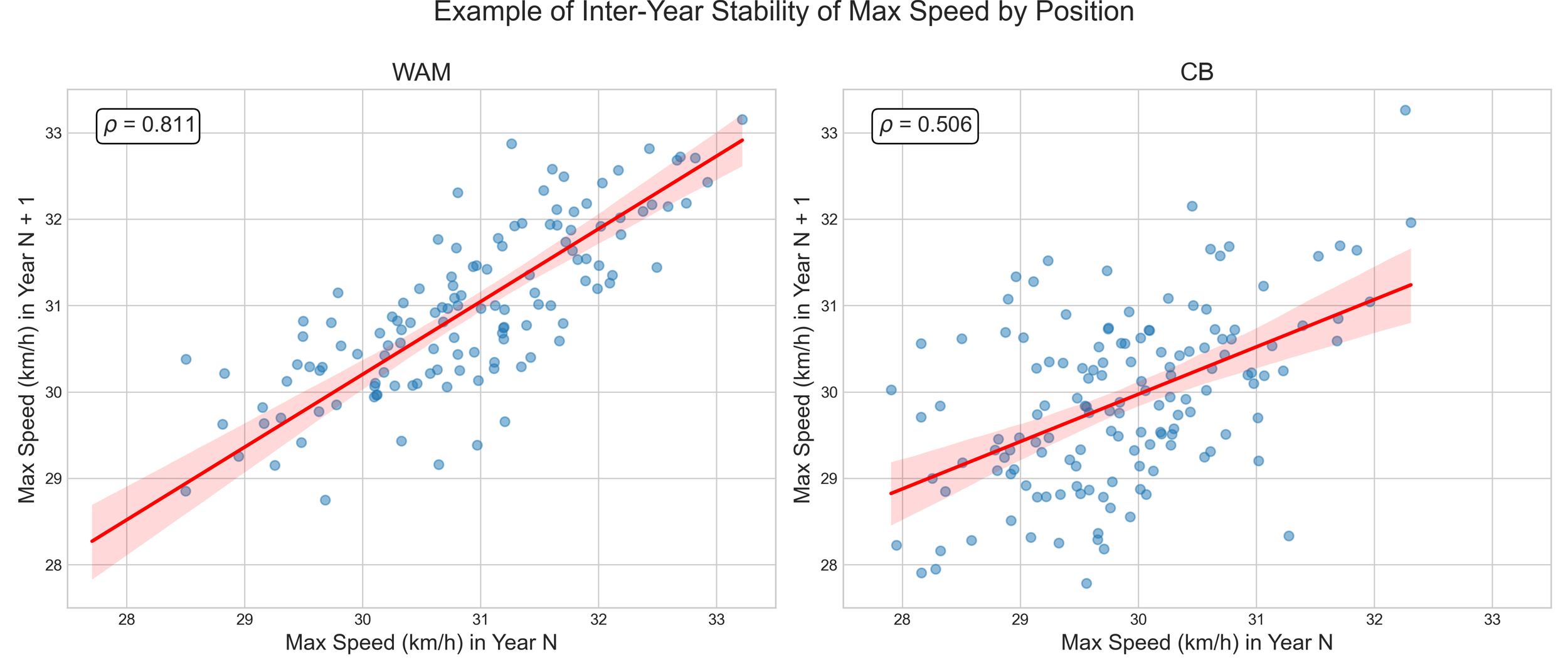PFF FC Athleticism Score: A Comprehensive Metric for Evaluating Athletic Performance in Football
Evaluating the athletic ability of football players has always been a tough challenge for sporting directors, scouts, and recruitment analysts. While broadcast tracking data has made physical metrics more accessible, figuring out which metrics matter for different positions is still challenging. That’s where our new approach comes in. On September 21, 2024, we presented a poster introducing PFF FC's Athleticism Score at Vancouver's 2024 CASSIS (Cascadia Symposium on Statistics in Sports). We've developed this comprehensive metric that quantifies a player’s physical abilities in a way that offers decision-makers a single, clear insight into their athletic performance. This gives clubs a powerful new tool for making informed decisions, using the right physical metrics for each position. Rather than trying to predict a player’s potential, our metrics are focused on what players actually do on the pitch, ensuring a realistic and practical evaluation.
One-Minute Intervals
The PFF FC Athleticism Score is derived from a comprehensive set of physical metrics measured for each player. Unlike American football, which is divided into plays between snaps, football is a continuous sport with minimal interruptions. To adjust for this dynamic nature of the sport, we calculate the physical metrics for every player at one-minute intervals, ensuring a detailed and accurate assessment of their athletic performance.
Aggregating Physical Metrics
To calculate a single score that quantifies player athleticism, we first need to aggregate the data from individual one-minute intervals over an entire season for each player. While using simple maximums (or minimums for metrics where 'lower is better') might seem straightforward, this approach often results in a large number of inaccurate data points due to noise in the broadcast tracking data. To reduce the impact of this noise, we use 95th or 99th percentiles instead of maximum values when aggregating player metrics when we observe unnatural outliers.
Figure 1: Distribution of maximum speed compared to the distribution of the 99th percentile of maximum speed.
The physical metrics are normalized by position for each player. We also differentiate between starting minutes and substitute minutes, recognizing that these roles can have distinct physical demands. Consequently, a player who has appeared in multiple positions and played both as a starter and a substitute will have multiple entries in our dataset.
To manage players with varying amounts of data, we scale z-scores based on the number of minutes played. This approach differs from standard normalization to handle both limited and extensive observations effectively. We cap the impact of data at 20% of available minutes, ensuring that players with more data can deviate meaningfully from the mean, while those with fewer minutes are treated conservatively. Players with very few observations are assigned a z-score of 0 to avoid outliers. This method helps prevent overfitting and ensures fair comparisons across all players.
Inter-Year Stability
Next, we compute a 'raw' athleticism score by taking a weighted sum of the aggregated metrics, where the weight assigned to each metric is based on its stability across multiple seasons. This stability is crucial in ensuring the reliability of the score over time. Our analysis uses data from the Premier League, spanning the 2020-2021 season until the 2023-2024 season. These weights are determined by position, grouping players together in position groups CB (Center Backs), FB (Full Backs), CM (Center Midfielders), WAM (Wingers & Attacking Midfielders) and CF (Center Forwards). Note that we do not allow for negative correlations, setting the weights equal to 0 in such cases. See Appendix B for all inter-year stability weights per position.
Figure 2: Inter-year stability of aggregated max speed for Wingers & Attacking Midfielders vs. Center Backs.
Although stability may not be the perfect method for weighting season-level metrics against each other, it offers the significant advantage of enhancing the reliability of the athleticism score. This improved stability not only aids in evaluating current player performance but also supports predicting future performance.
Adjustments For Height
The raw athleticism scores are calculated by weighting key metrics based on how stable they are across a season, reflecting how fast players move relative to their position. We also factor in player size, rewarding those who move faster than expected for their height. To do this, we use an XGBoost model that predicts athleticism based on height, with a separate model for each position. This model ensures that taller players aren’t unfairly boosted, as expected athleticism decreases with height. The final score is then adjusted by subtracting the expected score from the raw one, ensuring smaller sample sizes don’t result in an exaggerated boost. Ultimately, the final athleticism score gives a clear picture of player performance, factoring in both size and position.
Results
Applying our model to Premier League data from the 2023-2024 season reveals the top 5 most athletic players per position. We use percentile ranks within each position group to give a clearer picture of how players stack up, rather than relying on a score that lacks meaningful interpretation by itself. Equally interesting is examining the least athletic players per position in the Premier League.
If you would like to find out more information about our Athleticism Score and what it can do for your club or agency, get in touch at: marketing-fc@pff.com
PFF FC's poster introducing PFF FC's Athleticism Score at Vancouver's 2024 CASSIS (Cascadia Symposium on Statistics in Sports).






